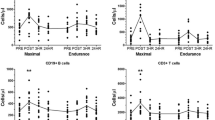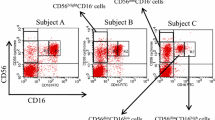Abstract
Distinct natural killer (NK) cell subsets (CD56bright and CD56dim) are mobilized with exercise and these cells may serve adaptive functions. We determined the distribution of NK cell subsets in response to exercise and carbohydrate (CHO) intake in young girls and compared these responses with previous findings in young boys of the same age. Twelve girls (12 years old) cycled for 60 min at 70% \( \ifmmode\expandafter\dot\else\expandafter\.\fi{V}{\text{O}}_{{{\text{2max}}}} \) while drinking 6% CHO or flavoured water. Blood was collected at rest, during (30 and 60 min) and following (30 and 60 min) exercise to identify NK cells as CD3−CD56bright or CD3−CD56dim. CD69 expression on total CD3−CD56+ cells was also determined. A trend (P = 0.07) was found for a trial × time interaction in CD56dim cell counts, with values lower with CHO than with water. CHO intake did not influence CD56bright responses (P ≥ 0.39). The CD56bright:CD56dim ratio increased during recovery from exercise (P < 0.001), compared to rest, with no effect of CHO intake (P = 0.48). CD69 expression was not different between exercise or recovery and rest. Like young boys, girls experience an elevated CD56bright:CD56dim ratio during recovery from exercise and CHO intake attenuates the exercise-induced CD56dim but not CD56bright cell response. Unlike young boys, girls do not experience a CHO-induced increase in the CD56bright:CD56dim ratio during recovery and CD69 expression does not increase on CD3−CD56+ cells during recovery. We conclude that even in young children sex-based differences exist in the NK cell response to exercise and CHO intake.


Similar content being viewed by others
References
Borrego F, Alonso MC, Galiani MD, Carracedo J, Ramirez R, Ostos B, Pena J, Solana R (1999) NK phenotypic markers and IL2 response in NK cells from elderly people. Exp Gerontol 34:253–265
Cooper MA, Fehniger TA, Caligiuri MA (2001a) The biology of human natural killer-cell subsets. Trends Immunol 22:633–640
Cooper MA, Fehniger TA, Turner SC, Chen KS, Ghaheri BA, Ghayur T, Carson WE, Caligiuri MA (2001b) Human natural killer cells: a unique innate immunoregulatory role for the CD56(bright) subset. Blood 97:3146–3151
Dalbeth N, Gundle R, Davies RJ, Lee YC, McMichael AJ, Callan MF (2004) CD56bright NK cells are enriched at inflammatory sites and can engage with monocytes in a reciprocal program of activation. J Immunol 173:6418–6426
Fehniger TA, Cooper MA, Nuovo GJ, Cella M, Facchetti F, Colonna M, Caligiuri MA (2003) CD56bright natural killer cells are present in human lymph nodes and are activated by T cell-derived IL-2: a potential new link between adaptive and innate immunity. Blood 101:3052–3057
Jacobs R, Stoll M, Stratmann G, Leo R, Link H, Schmidt RE (1992) CD16- CD56+ natural killer cells after bone marrow transplantation. Blood 79:3239–3244
King A, Burrows T, Verma S, Hiby S, Loke YW (1998) Human uterine lymphocytes. Hum Reprod Update 4:480–485
Lanier LL, Buck DW, Rhodes L, Ding A, Evans E, Barney C, Phillips JH (1988) Interleukin 2 activation of natural killer cells rapidly induces the expression and phosphorylation of the Leu-23 activation antigen. J Exp Med 167:1572–1585
Lanier LL, Le AM, Civin CI, Loken MR, Phillips JH (1986) The relationship of CD16 (Leu-11) and Leu-19 (NKH-1) antigen expression on human peripheral blood NK cells and cytotoxic T lymphocytes. J Immunol 136:4480–4486
Lash GE, Schiessl B, Kirkley M, Innes BA, Cooper A, Searle RF, Robson SC, Bulmer JN (2006) Expression of angiogenic growth factors by uterine natural killer cells during early pregnancy. J Leukoc Biol 80:572–580
Mahoney DJ, Parise G, Melov S, Safdar A, Tarnopolsky MA (2005) Analysis of global mRNA expression in human skeletal muscle during recovery from endurance exercise. FASEB J 19:1498–1500
Marra S, Burnett M, Hoffman-Goetz L (2005) Intravenous catecholamine administration affects mouse intestinal lymphocyte number and apoptosis. J Neuroimmunol 158:76–85
McCarthy DA, Dale MM (1988) The leukocytosis of exercise: a review and model. Sports Med 6:333–363
Nieman DC (1998) Influence of carbohydrate on the immune response to intensive, prolonged exercise. Exerc Immunol Rev 4:64–76
Nieman DC (2000) Carbohydrates and the immune response to prolonged exertion. In: Nieman DC, Pedersen BK (eds) Nutrition and exercise immunology. CRC Press, Boca Raton, pp 25–42
Page GG, Ben Eliyahu S (2000) Natural killer cell activity and resistance to tumor metastasis in prepubescent rats: deficient baselines, but invulnerability to stress and beta-adrenergic stimulation. Neuroimmunomodulation 7:160–168
Pedersen BK, Ullum H (1994) NK cell response to physical activity: possible mechanisms of action. Med Sci Sports Exerc 26:140–146
Shephard RJ, Shek PN (1999) Effects of exercise and training on natural killer cell counts and cytolytic activity: a meta-analysis. Sports Med 28:177–195
Simms PE, Ellis TM (1996) Utility of flow cytometric detection of CD69 expression as a rapid method for determining poly- and oligoclonal lymphocyte activation. Clin Diagn Lab Immunol 3:301–304
Suzui M, Kawai T, Kimura H, Takeda K, Yagita H, Okumura K, Shek PN, Shephard RJ (2004) Natural killer cell lytic activity and CD56(dim) and CD56(bright) cell distributions during and after intensive training. J Appl Physiol 96:2167–2173
Tanner JM (1962) Growth at adolescence, Blackwell Scientific, Oxford, pp 32–37
Timmons BW (2005) Paediatric exercise immunology: health and clinical applications. Exerc Immunol Rev 11:108–144
Timmons BW, Tarnopolsky MA, Bar-Or O (2004) Immune responses to strenuous exercise and carbohydrate intake in boys and men. Pediatr Res 56:227–234
Timmons BW, Tarnopolsky MA, Bar-Or O (2006a) Sex-based effects on the distribution of NK cell subsets in response to exercise and carbohydrate intake in adolescents. J Appl Physiol 100:1513–1519
Timmons BW, Tarnopolsky MA, Snider DP, Bar-Or O (2006b) Immunological changes in response to exercise: influence of age, puberty, and gender. Med Sci Sports Exerc 38:293–304
Timmons BW, Tarnopolsky MA, Snider DP, Bar-Or O (2006c) Puberty effects on NK cell responses to exercise and carbohydrate intake in boys. Med Sci Sports Exerc 38:864–874
Westermann J, Pabst R (1992) Distribution of lymphocyte subsets and natural killer cells in the human body. Clin Investig 70:539–544
Yovel G, Shakhar K, Ben Eliyahu S (2001) The effects of sex, menstrual cycle, and oral contraceptives on the number and activity of natural killer cells. Gynecol Oncol 81:254–262
Acknowledgments
This work was funded through generous support by the Gatorade Sports Science Institute and BD Biosciences. We thank Melanie De Jonge, Marta Kubacki, Raymond Trott, Jae-Hunn Lee, Mazen Hamadeh, and Amy Mark for assistance with this experiment. The extraordinary effort and time of the girls who participated are gratefully acknowledged. Acquisition of flow cytometry data was performed in the McMaster Flow Cytometry Facility, supported by the Canadian Institutes of Health Research. Sadly, Dr. Oded Bar-Or passed away before submission of this manuscript; his numerous contributions to pediatric exercise science will never be forgotten.
Author information
Authors and Affiliations
Corresponding author
Rights and permissions
About this article
Cite this article
Timmons, B.W., Bar-Or, O. Evidence of sex-based differences in natural killer cell responses to exercise and carbohydrate intake in children. Eur J Appl Physiol 101, 233–240 (2007). https://doi.org/10.1007/s00421-007-0495-7
Accepted:
Published:
Issue Date:
DOI: https://doi.org/10.1007/s00421-007-0495-7




